We left Alice Springs on a Virgin Australia flight late in the afternoon and arrived in Darwin, the Northern Territory’s capital just before sunset. Darwin is on the Timor Sea and is the largest city in the sparsely populated territory. We’ve rented another 4×4 for more off road adventures as we explore Australia’s “Top End”, including Kakadu, Katherine Gorge, and Litchfield national parks!
Darwin
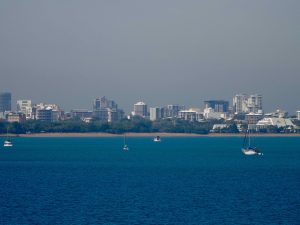 After checking into the Argus Hotel in Darwin, we had a late dinner at Rorkes. We enjoyed the local snapper, clams, barramundi and salmon roe. Rorkes is a good beer stop too with the taps scattered around the bar and even at the tables, self serve! You insert prepaid cards to fill your ice cold schooner. We also were able to watch some of “State of Origin” best of three Australian rugby league football between Queensland and New South Wales. To the pleasure of most pub patrons clad in maroon and gold, Queensland was victorious…a close, entertaining game!
After checking into the Argus Hotel in Darwin, we had a late dinner at Rorkes. We enjoyed the local snapper, clams, barramundi and salmon roe. Rorkes is a good beer stop too with the taps scattered around the bar and even at the tables, self serve! You insert prepaid cards to fill your ice cold schooner. We also were able to watch some of “State of Origin” best of three Australian rugby league football between Queensland and New South Wales. To the pleasure of most pub patrons clad in maroon and gold, Queensland was victorious…a close, entertaining game!
The next day after breakfast at our Darwin hotel, we made a very warm 3 km walk to the Museum and Art Gallery of the Northern Territory. The walk felt like summer in Florida! Ten am and already 80 and humid!
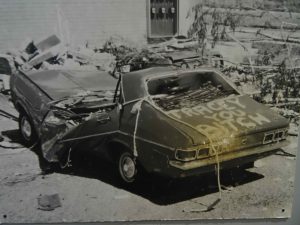
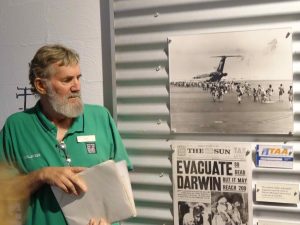 The museum itself has many exhibits, one interesting and “close to home” for us was Cyclone Tracy. Cyclone Tracy hit Darwin on Christmas Eve 1974 and was a compact category 4 hurricane. It devastated Darwin, including 60 percent of its buildings and 40 percent of its trees. There were 71 deaths. The intensity of the storm was not expected, but it changed course, headed straight for Darwin and it hovered over the area for hours. It led to the largest evacuation in Australian history. Over 35,000 people were evacuated and just over 10,000 remained after the evacuations. Many of course never returned. Our museum guide was one of the survivors and told us the harrowing details of the night and aftermath, in great Aussie fashion, as if it was just a blip in the road.
The museum itself has many exhibits, one interesting and “close to home” for us was Cyclone Tracy. Cyclone Tracy hit Darwin on Christmas Eve 1974 and was a compact category 4 hurricane. It devastated Darwin, including 60 percent of its buildings and 40 percent of its trees. There were 71 deaths. The intensity of the storm was not expected, but it changed course, headed straight for Darwin and it hovered over the area for hours. It led to the largest evacuation in Australian history. Over 35,000 people were evacuated and just over 10,000 remained after the evacuations. Many of course never returned. Our museum guide was one of the survivors and told us the harrowing details of the night and aftermath, in great Aussie fashion, as if it was just a blip in the road.
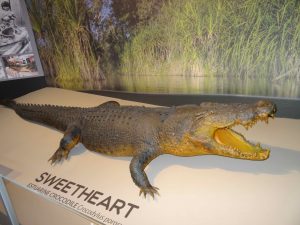 The museum is home to “Sweetheart”, a legendary, large male Saltwater Crocodile. He was known for attacking dinghies in the area and even boat motors, legend has it. He was over 16 feet long and was estimated to be over 50 years old when he died during an attempted capture to relocate him.
The museum is home to “Sweetheart”, a legendary, large male Saltwater Crocodile. He was known for attacking dinghies in the area and even boat motors, legend has it. He was over 16 feet long and was estimated to be over 50 years old when he died during an attempted capture to relocate him.
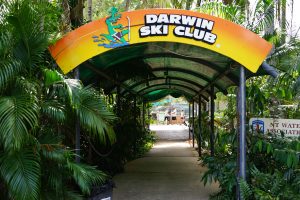
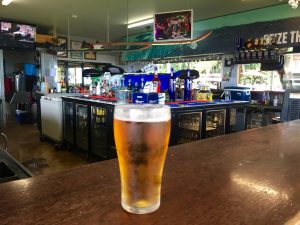 We left the museum just after lunch and headed across the street to the Darwin Ski Club for lunch on the water. They have a nice menu and bar area outside by the beach. I had the seafood basket of scallops, calamari, fish, prawns, and of course, chips. Tracey was much better having the beet root salad.
We left the museum just after lunch and headed across the street to the Darwin Ski Club for lunch on the water. They have a nice menu and bar area outside by the beach. I had the seafood basket of scallops, calamari, fish, prawns, and of course, chips. Tracey was much better having the beet root salad. 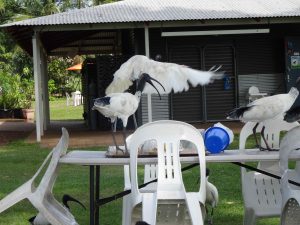 We had the Australian White Ibis helping us eat our lunch. They would attack the tables as soon as people got up to leave, cleaning up any leftovers!
We had the Australian White Ibis helping us eat our lunch. They would attack the tables as soon as people got up to leave, cleaning up any leftovers!
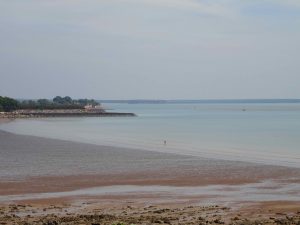
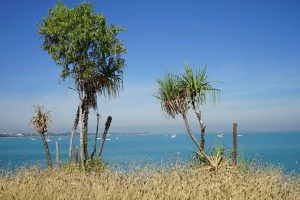 We headed back to the hotel, a nice walk in the heat…not! It reminded me of why I want to avoid Florida in the summer! For the evening we headed down to the Mindil Beach Sunset Market, a local favorite event that runs every Thursday and Sunday evening in the winter months. The market supports over 300 local small businesses! There was a good crowd, lots of food of all types, music and of course arts and crafts. I went for the Chicken Laska from the Darwin Laska Co., and Tracey tested the curry chicken.
We headed back to the hotel, a nice walk in the heat…not! It reminded me of why I want to avoid Florida in the summer! For the evening we headed down to the Mindil Beach Sunset Market, a local favorite event that runs every Thursday and Sunday evening in the winter months. The market supports over 300 local small businesses! There was a good crowd, lots of food of all types, music and of course arts and crafts. I went for the Chicken Laska from the Darwin Laska Co., and Tracey tested the curry chicken.
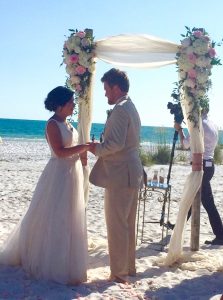 The next morning we woke up early for my nephew Steve’s Wedding on Anna Maria Island, Florida. We had a great friend Facetime part of it for us at 7 a.m. our time. Not the same as being there but we were able to see some of Steve and Taylor’s beautiful wedding, cake cutting and dancing!
The next morning we woke up early for my nephew Steve’s Wedding on Anna Maria Island, Florida. We had a great friend Facetime part of it for us at 7 a.m. our time. Not the same as being there but we were able to see some of Steve and Taylor’s beautiful wedding, cake cutting and dancing!
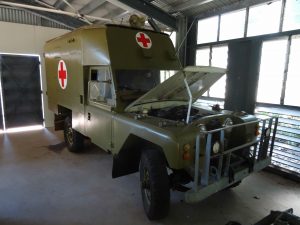
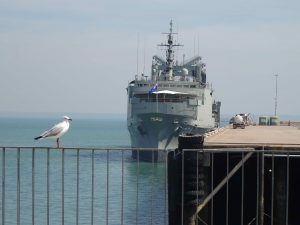 Tracey took the “day off”, but I went to the Darwin Military Museum, including the Defence of Darwin Experience. The Defence experience tells the story of the “Bombing of Darwin” by the Japanese on February 19, 1942 through film, audio, and an impressive collection. The bombing was the largest single attack ever mounted by a foreign power on Australia. Approximately 250 people were killed that day and many of the 65 allied warships and merchant vessels in the harbor were damaged or destroyed by 188 Japanese planes…the USS Peary Destroyer among them including 88 deaths. Much of the town was destroyed. The initial raid was similar to Pearl Harbor in terms of the surprise element. Darwin actually saw more bombs dropped than Pearl Harbor but of course the deaths in Pearl Harbor were greater due in part to the sinking of the USS Arizona battleship. In the couple months prior to the raids in December most women and children had been evacuated in anticipation. Darwin was raided over 107 times in 1942 leading to incredible destruction!
Tracey took the “day off”, but I went to the Darwin Military Museum, including the Defence of Darwin Experience. The Defence experience tells the story of the “Bombing of Darwin” by the Japanese on February 19, 1942 through film, audio, and an impressive collection. The bombing was the largest single attack ever mounted by a foreign power on Australia. Approximately 250 people were killed that day and many of the 65 allied warships and merchant vessels in the harbor were damaged or destroyed by 188 Japanese planes…the USS Peary Destroyer among them including 88 deaths. Much of the town was destroyed. The initial raid was similar to Pearl Harbor in terms of the surprise element. Darwin actually saw more bombs dropped than Pearl Harbor but of course the deaths in Pearl Harbor were greater due in part to the sinking of the USS Arizona battleship. In the couple months prior to the raids in December most women and children had been evacuated in anticipation. Darwin was raided over 107 times in 1942 leading to incredible destruction!
Kakadu National Park
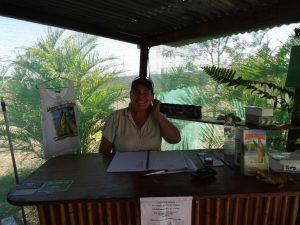
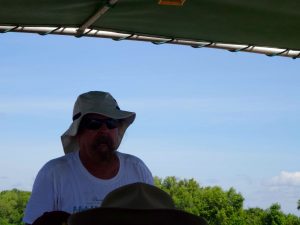 The next day we Headed out for Kakadu National Park for a two night stay at the Kakadu Lodge. About an hour outside of Darwin we stopped at the Adelaide River Jumping Croc Cruise! They had a couple of spots open and we had an awesome trip, thanks to Harry and Bridget! They are great friendly people that help you make sure you don’t hang your hand over the side of the boat! They said they haven’t lost anybody in the eight years or so they have been operating but you could see how someone could lose a finger, hand, or arm in all the fun.
The next day we Headed out for Kakadu National Park for a two night stay at the Kakadu Lodge. About an hour outside of Darwin we stopped at the Adelaide River Jumping Croc Cruise! They had a couple of spots open and we had an awesome trip, thanks to Harry and Bridget! They are great friendly people that help you make sure you don’t hang your hand over the side of the boat! They said they haven’t lost anybody in the eight years or so they have been operating but you could see how someone could lose a finger, hand, or arm in all the fun. 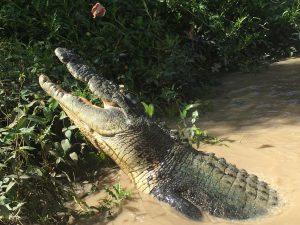
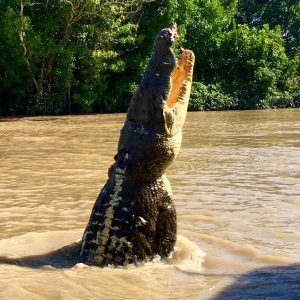 The crocs sneak up and surround the boat. And they are quite large, 7 meters or more and well over a ton. And some nearly 100 years old! I expected going on a croc cruise to be cheesy, but this was awesome!
The crocs sneak up and surround the boat. And they are quite large, 7 meters or more and well over a ton. And some nearly 100 years old! I expected going on a croc cruise to be cheesy, but this was awesome!
We ventured on and stopped at a nearby station for lunch, the Corroboree Park Station and Tavern. Great friendly staff! I had the healthy selection… an awesome Chicken Schnitzel and Avocado burger!
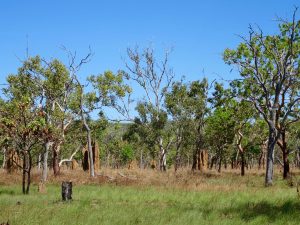
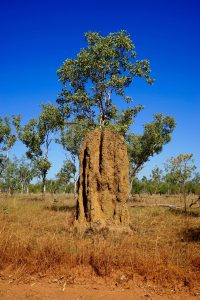 As you make the drive to the park it is mostly flat, scrubby landscape. The area is one large floodplain that spends much of the winter season covered in water resulting from the monsoonal rains and storms. Just about every dip in the road has the “metre” stick beside it to alert drivers how many metres deep the water is when the road floods. I suppose a bit like Florida, its swamps and Everglades before much of it was drained for development. There are a few mango farms along the way and the enormous termite hills are abundant, many two or three meters and taller, looking like large intricate sandcastles. Their architecture and building skills are amazing!
As you make the drive to the park it is mostly flat, scrubby landscape. The area is one large floodplain that spends much of the winter season covered in water resulting from the monsoonal rains and storms. Just about every dip in the road has the “metre” stick beside it to alert drivers how many metres deep the water is when the road floods. I suppose a bit like Florida, its swamps and Everglades before much of it was drained for development. There are a few mango farms along the way and the enormous termite hills are abundant, many two or three meters and taller, looking like large intricate sandcastles. Their architecture and building skills are amazing!
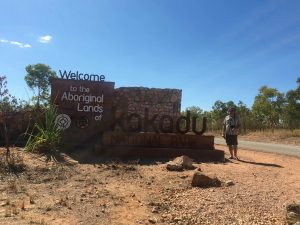 Surviving the croc, we eventually made it to Kakadu Lodge in Jabiru. The only small grocery was closed. Not much here but a couple caravan parks and a hotel shaped like a crocodile! It was reassuring to see a snake slither across a sidewalk as we went to check into our place.
Surviving the croc, we eventually made it to Kakadu Lodge in Jabiru. The only small grocery was closed. Not much here but a couple caravan parks and a hotel shaped like a crocodile! It was reassuring to see a snake slither across a sidewalk as we went to check into our place.
We quickly moved into our lodge room at the park and went about exploring, visiting the Kakadu Park info center. We mapped out our drives for our stay. Given that temperatures feel like Florida in the summer and there is no swimming in the waters in the park due to the crocodiles, we will focus more on the four-wheel drive air conditioned touring!
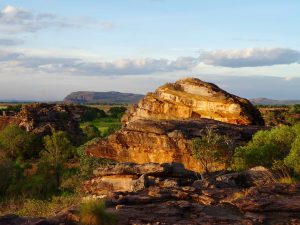
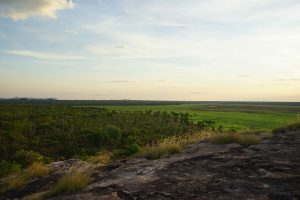 In the evening we drove to Ubirr for sunset…A must do! Ubirr is about 40 km from Jabiru on a now sealed road. The cliffs above the plains, or escarpments contain Aboriginal rock paintings, most 2000 years old! The views across the floodplains at sunset are awesome from some easily accessible cliffs. There were many people that converged on this spot for sunset, almost in a ritualistic manner it seemed. The park ranger waits to help ensure folks make it safely down the rocks after sunset.
In the evening we drove to Ubirr for sunset…A must do! Ubirr is about 40 km from Jabiru on a now sealed road. The cliffs above the plains, or escarpments contain Aboriginal rock paintings, most 2000 years old! The views across the floodplains at sunset are awesome from some easily accessible cliffs. There were many people that converged on this spot for sunset, almost in a ritualistic manner it seemed. The park ranger waits to help ensure folks make it safely down the rocks after sunset.
We arrived back at Kakadu Lodge for a poolside dinner of Rogan Josh and a nice cool bottle of Chardonnay! The small cafe at the park is one of only a couple options for dinner in the area! We opted for this of course rather than cooking at the lodge’s shared kitchen and BBQ.
We were up at sunrise the next morning, ready to start our day of exploring. We prepped our lunch and cooler for the day and headed out.
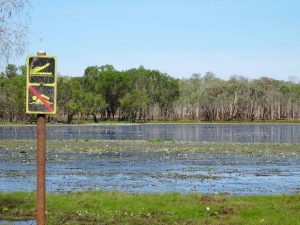
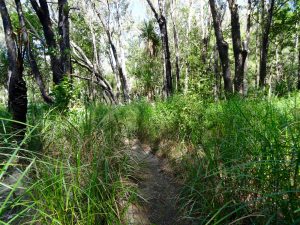 Our first stop was the Anbangbang Billabong, less than a 30 minute drive from the Kakadu Lodge. The billabong was speckled in white lilies and variety of birds. There were crocodile caution signs all over the area and signs that there had been sightings. This made us quite nervous and we were actually relieved when we were halfway through the trek and saw that the remainder of the track was closed. Still it was a beautiful walk that gave us a view of one of natures most interesting cycles of summer monsoon and hot dry winter cycles.
Our first stop was the Anbangbang Billabong, less than a 30 minute drive from the Kakadu Lodge. The billabong was speckled in white lilies and variety of birds. There were crocodile caution signs all over the area and signs that there had been sightings. This made us quite nervous and we were actually relieved when we were halfway through the trek and saw that the remainder of the track was closed. Still it was a beautiful walk that gave us a view of one of natures most interesting cycles of summer monsoon and hot dry winter cycles.
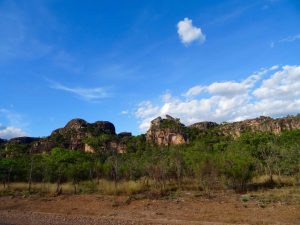
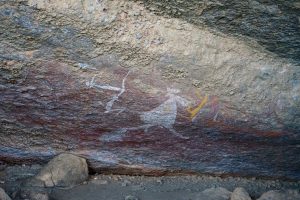 We continued on a few more kilometers and came to Nourlangie (Burrunggui). This is a remarkable area of cliffs and escarpment that contain areas of natural Aboriginal shelter and outstanding art sites.
We continued on a few more kilometers and came to Nourlangie (Burrunggui). This is a remarkable area of cliffs and escarpment that contain areas of natural Aboriginal shelter and outstanding art sites. 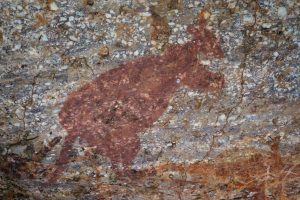
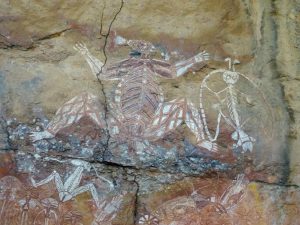 There are areas of art here telling many stories that are hundreds and even thousands of years old.
There are areas of art here telling many stories that are hundreds and even thousands of years old.
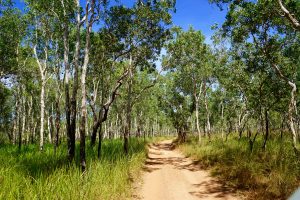
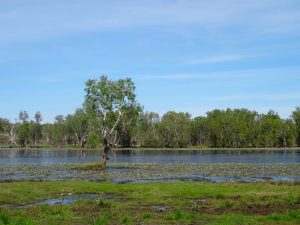 After stopping back at the Anbangbang Billabong for lunch with a great view, we headed out to Sandy Billabong. This billabong was more remote, including a 6 km ride on a four-wheel drive trek. Much of this drive includes the corrugated sandy surface (or “washboarding”) that makes for the most unpleasant noisy, bumpy ride. It was still a rewarding drive though! The billabong was much larger and the drive was through a beautiful forest and tall grass covered plain. There was a remote campsite here as well…that had no campers during our visit.
After stopping back at the Anbangbang Billabong for lunch with a great view, we headed out to Sandy Billabong. This billabong was more remote, including a 6 km ride on a four-wheel drive trek. Much of this drive includes the corrugated sandy surface (or “washboarding”) that makes for the most unpleasant noisy, bumpy ride. It was still a rewarding drive though! The billabong was much larger and the drive was through a beautiful forest and tall grass covered plain. There was a remote campsite here as well…that had no campers during our visit.
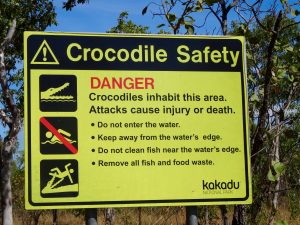 In 2002, a few tourists decided to take a midnight swim here. Unfortunately, for one, this was a fatal mistake. A crocodile snatched her less than 10 meters from the bank. There are croc warning signs all over. Not sure why it was tempting to test it. Tracey was afraid to get out of the car. Aside from the crocs, this is apparently a good fishing spot for barramundi, tarpon, and saratoga.
In 2002, a few tourists decided to take a midnight swim here. Unfortunately, for one, this was a fatal mistake. A crocodile snatched her less than 10 meters from the bank. There are croc warning signs all over. Not sure why it was tempting to test it. Tracey was afraid to get out of the car. Aside from the crocs, this is apparently a good fishing spot for barramundi, tarpon, and saratoga.
We stopped again at the information center on the way back to the lodge and went through its small museum and watched a one hour film about Kakadu. The film provided a great overview of this world heritage site and second largest national park in the world (link to the video → Kakadu National Park Video). Kakadu National Park is just incredible and its biodiversity is amazing. It has evidence of human life 20,000 years ago! The area had a significant Aboriginal population with rock paintings 1,000s of years old.
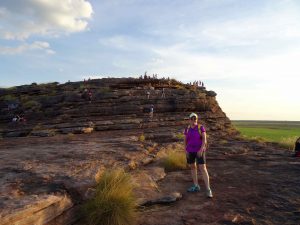
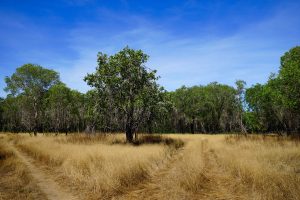
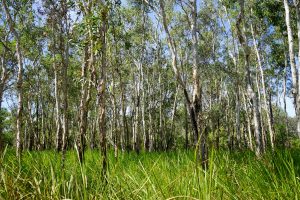 In Kakadu, there is a monsoon season where streams turn to rivers and plains turn to lakes. There are 68 different kinds of mammals, 300 types of tidal and freshwater fish, more than 2,000 plant species and 10,000 insect types. There are nearly 300 bird species and the climate makes it a significant place for migratory birds. During wet season, there are roaring falls, including massive twin falls. The crocodile is challenged in the rivers by three different types of sharks, including bull sharks. We saw an alligator that was nearly 20 foot that had lost a leg to a bull shark!
In Kakadu, there is a monsoon season where streams turn to rivers and plains turn to lakes. There are 68 different kinds of mammals, 300 types of tidal and freshwater fish, more than 2,000 plant species and 10,000 insect types. There are nearly 300 bird species and the climate makes it a significant place for migratory birds. During wet season, there are roaring falls, including massive twin falls. The crocodile is challenged in the rivers by three different types of sharks, including bull sharks. We saw an alligator that was nearly 20 foot that had lost a leg to a bull shark!
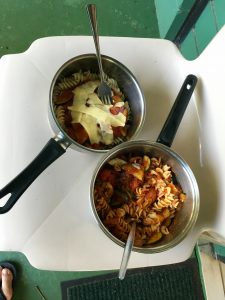 Returning back to the lodge, we went for a dip in the outdoor pool which was cool and quite refreshing! We avoided the cafe for this night’s dinner and cooked a nice pasta dinner with a red pepper, zucchini, onion tomato sauce! A bit like camping! Off to bed early for more adventure on the drive to Katherine Gorge in the morning.
Returning back to the lodge, we went for a dip in the outdoor pool which was cool and quite refreshing! We avoided the cafe for this night’s dinner and cooked a nice pasta dinner with a red pepper, zucchini, onion tomato sauce! A bit like camping! Off to bed early for more adventure on the drive to Katherine Gorge in the morning.
On to Katherine Gorge
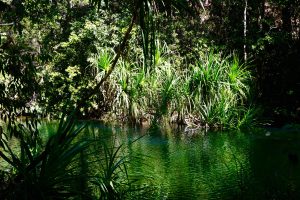
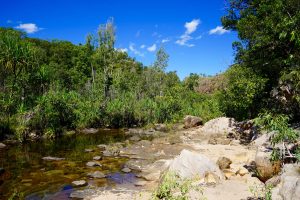 On the road early today! Our first stop is Maguk (Barramundi Gorge) and it is a terrific spot! After a 14 km drive on an unsealed and more “corrugated” road, ideal for four-wheel drive vehicles, the start of the beautiful 2 km return trek begins. The first section journeys through forest and heavy lush vegetation. The walk follows along the stream and then becomes a bit rockier, eventually crossing the stream. The day we were there it was possible to walk atop the rocks carefully without soaking our walking shoes or needing to go barefoot.
On the road early today! Our first stop is Maguk (Barramundi Gorge) and it is a terrific spot! After a 14 km drive on an unsealed and more “corrugated” road, ideal for four-wheel drive vehicles, the start of the beautiful 2 km return trek begins. The first section journeys through forest and heavy lush vegetation. The walk follows along the stream and then becomes a bit rockier, eventually crossing the stream. The day we were there it was possible to walk atop the rocks carefully without soaking our walking shoes or needing to go barefoot. 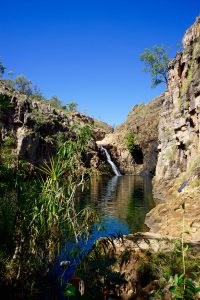
After climbing across the rocks along the stream the opening appears with steep gorge walls, a large pristine waterfall and a large deep pool. Maguk is one of the only falls in Kakadu National Park that flows all year, with the flow decreasing during the dry winter months. We hit the waterfall when there was plenty of water flowing! While we did not see many folks while hiking to the falls, once we arrived there were several swimmers enjoying the refreshing water on this hot day.
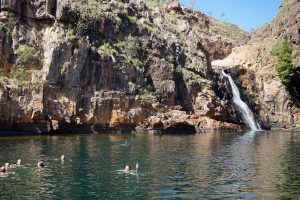 Up to this point I had wondered why one would swim in waters with potential crocodile. After the warm hike and seeing this beautiful spot I discovered why and joined the swimmers! Tracey stayed onshore and decided to play photographer for a while!
Up to this point I had wondered why one would swim in waters with potential crocodile. After the warm hike and seeing this beautiful spot I discovered why and joined the swimmers! Tracey stayed onshore and decided to play photographer for a while!
We arrived in the town of Katherine late afternoon and checked into the Beagle Motor Inn, a modest motel that has had some refresh. The town itself felt a little like a much smaller Alice Springs. We did have a terrific dinner at the Beagle Inn of lamb roast, potatoes and veggies and were joined by some Melbournians, retired teachers that were vacationing in the area.
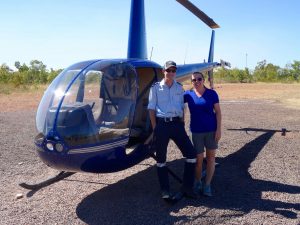
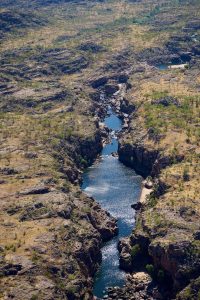 The next day we decided to do a couple tours of Katherine Gorge, one by water and one by air. We took the 13 gorge helicopter tour in the late morning with HeliSpirit. It was fantastic! It was a small four seat small helicopter that made you feel like you were one with the birds. Strapped in by only a car seat belt, doors removed, and strong wind gusts, we were airborne. It felt a bit like an amusement park ride, but a little more terrifying. The pilot looked all of 12-years old. This is probably more of a reflection of our age versus his. It really made you feel alive, and crazy at the same time. All your senses were heightened. We still had some goose bumps most of the day.
The next day we decided to do a couple tours of Katherine Gorge, one by water and one by air. We took the 13 gorge helicopter tour in the late morning with HeliSpirit. It was fantastic! It was a small four seat small helicopter that made you feel like you were one with the birds. Strapped in by only a car seat belt, doors removed, and strong wind gusts, we were airborne. It felt a bit like an amusement park ride, but a little more terrifying. The pilot looked all of 12-years old. This is probably more of a reflection of our age versus his. It really made you feel alive, and crazy at the same time. All your senses were heightened. We still had some goose bumps most of the day.
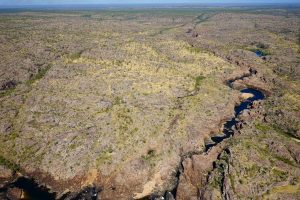
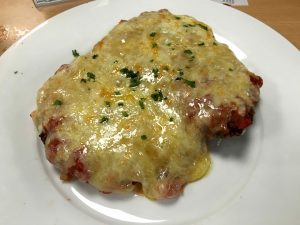 For dinner, we ate at the Katherine Club, also known as the RSL, Returned Services League. They had parma mania night…you get a free drink with your parm-chicken schnitzel order! Another delicious, healthy outback meal washed down with a delicious cold Carlton Dry draught beer.
For dinner, we ate at the Katherine Club, also known as the RSL, Returned Services League. They had parma mania night…you get a free drink with your parm-chicken schnitzel order! Another delicious, healthy outback meal washed down with a delicious cold Carlton Dry draught beer.
After dinner we saw our pilots from the helicopter service. We spent an hour or so talking to them about world travels and Australia. One of the mates was from Sydney via South Africa. We had some great conversation and received some good tips on Sydney as well as other world travels. South Africa is on our list. The younger pilot, Jerry, was from Perth via Canada where his family moved many years ago on an agricultural visa. Jerry learn to fly in the Perth area and just recently was stationed here in Katherine to do flights over the gorge.
We checked out of the Beagle Motor Inn early the next morning to make our 30 minute drive to the Katherine Gorge National Park to start our boat cruise. The morning was actually kind of cool with the temperatures in the upper 60s…but not to be fooled as it will be in the mid 90s and very hot today!
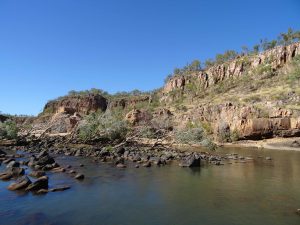
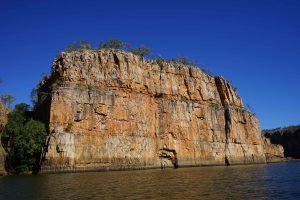 Today we took a two-hour Nitmiluk Gorge cruise on the Katherine River which gave us a different perspective than the helicopter the day before. The river at this time of the year is relatively shallow. Several meters of rain (about 250 inches) fill this area each summer filling the rivers. This leads to more saltwater crocs in the summer and mostly freshwater crocs in the winter season. We were able to see their tracks on some of the sandy shore areas.
Today we took a two-hour Nitmiluk Gorge cruise on the Katherine River which gave us a different perspective than the helicopter the day before. The river at this time of the year is relatively shallow. Several meters of rain (about 250 inches) fill this area each summer filling the rivers. This leads to more saltwater crocs in the summer and mostly freshwater crocs in the winter season. We were able to see their tracks on some of the sandy shore areas.
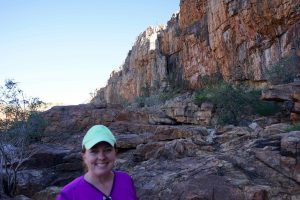
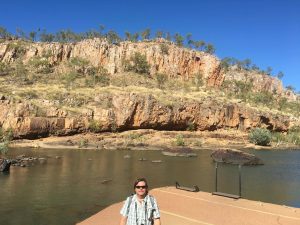 The water is low this time of the year so the boat can only take you so far through one gorge before the rocks present themselves in the middle of the river. At this point you have to get off the boat and make a short trek to the other side of the rocks where another boat is waiting to take you through the second gorge. This area also has one day to several day camping hikes or kayak trips that you can take through the gorge.
The water is low this time of the year so the boat can only take you so far through one gorge before the rocks present themselves in the middle of the river. At this point you have to get off the boat and make a short trek to the other side of the rocks where another boat is waiting to take you through the second gorge. This area also has one day to several day camping hikes or kayak trips that you can take through the gorge.
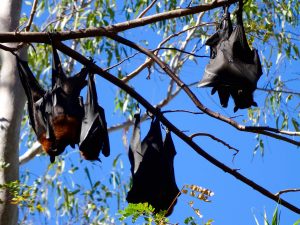
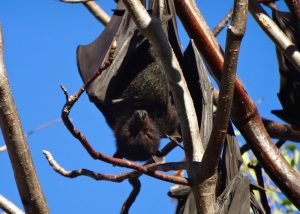 One interesting aspect to this river cruise is when you arrive at the car park there are “flying foxes” or fox bats by the hundreds hanging and screeching in the surrounding trees! Aside from these freaky mammals, there are also many kinds of birds in the area. And of course this area has a long aboriginal history including more rock art on the walls of the gorges.
One interesting aspect to this river cruise is when you arrive at the car park there are “flying foxes” or fox bats by the hundreds hanging and screeching in the surrounding trees! Aside from these freaky mammals, there are also many kinds of birds in the area. And of course this area has a long aboriginal history including more rock art on the walls of the gorges.
Litchfield National Park
Our boat tour ended and we headed back through Katherine on our way to Litchfield National Park, the last park stay during our Top-End tour of Australia’s Northwest Territory. Our new home for the next two nights is the Lichfield Tourist Park just outside park. There is only a place or two to eat in the Litchfield area so we are bringing in a few groceries to do some cooking at our cabin. There is only one place to stop for groceries on the way to Litchfield in the town of Batchelor at the General Store – and not a wide selection of items!
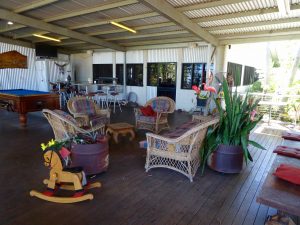
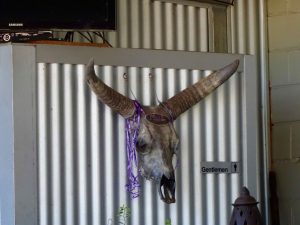 Along the way we had some lunch at the Bent Bull Bar and Grill in Emerald Springs…the only thing in Emerald Springs, a stop on Stuart Highway. But quite a nice roadhouse! Tracey had a hamburger and I had a barra burger (barramundi fish) and chips…starting the diet tomorrow!
Along the way we had some lunch at the Bent Bull Bar and Grill in Emerald Springs…the only thing in Emerald Springs, a stop on Stuart Highway. But quite a nice roadhouse! Tracey had a hamburger and I had a barra burger (barramundi fish) and chips…starting the diet tomorrow!
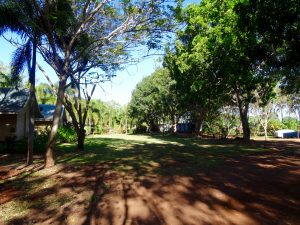 We made it to Litchfield mid afternoon and checked into our cabin. This tourist park, with a few cabins and a swimming pool are one of just a couple places to stay in the area. Also, there is no internet and no phone service in the park…kinda nice, not many places in the world like this anymore where you don’t have a choice to “stay connected”.
We made it to Litchfield mid afternoon and checked into our cabin. This tourist park, with a few cabins and a swimming pool are one of just a couple places to stay in the area. Also, there is no internet and no phone service in the park…kinda nice, not many places in the world like this anymore where you don’t have a choice to “stay connected”.
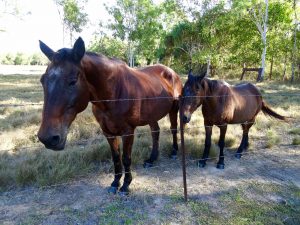 Our cabin was about the size of a shipping container, as a matter of fact I think it was a shipping container! It had air con and was nice and cool. We unpacked and took a walk down to the Upper Finnis River, but not too close as there was a “no swimming due to crocs” posting nearby. We did visit a rather harmless horse and pony in a nearby field that wanted some attention.
Our cabin was about the size of a shipping container, as a matter of fact I think it was a shipping container! It had air con and was nice and cool. We unpacked and took a walk down to the Upper Finnis River, but not too close as there was a “no swimming due to crocs” posting nearby. We did visit a rather harmless horse and pony in a nearby field that wanted some attention.
We cooked dinner as the same old pub food is getting a little old due to the frequency. We grilled some chicken, roasted a brussel sprout-onion medley and baked a sweet potato. The chicken was seasoned with cumin, turmeric and salt and pepper, and our “secret” spices (and the only spices we had at the moment). This was paired with with a Barossa Valley Shiraz.
We had a great day in the park the following day. Being much smaller than Kakadu, we were able to cover much of it in our only full day here by driving and hiking.
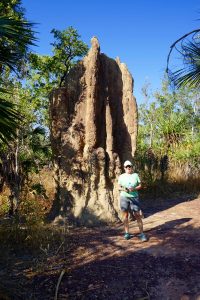
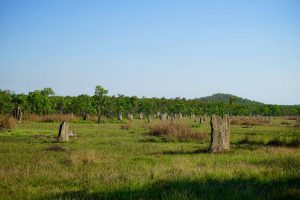 Just about 12 km into the park, we stopped at the termite mounds. We saw many of these throughout Kakadu National Park, however these seemed more concentrated. These smart magnetic termites build these from north to south to ensure a natural air conditioning. Their architecture is incredible as some of these structures are 15 ft tall and over 50 years old! The mounds were so numerous in a couple of fields, some looking like cemeteries full of headstones.
Just about 12 km into the park, we stopped at the termite mounds. We saw many of these throughout Kakadu National Park, however these seemed more concentrated. These smart magnetic termites build these from north to south to ensure a natural air conditioning. Their architecture is incredible as some of these structures are 15 ft tall and over 50 years old! The mounds were so numerous in a couple of fields, some looking like cemeteries full of headstones.
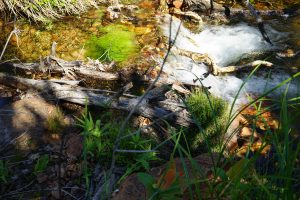
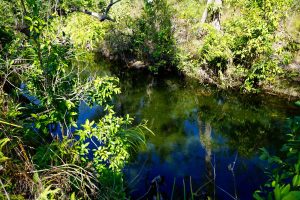 We decided to drive 60 km out to the northwest edge of the park and work are way back. We stopped at Walker Creek and trekked a couple of miles along this beautiful creek and bush. We didn’t make it to the rock pool as it was getting pretty hot by 10 am and we wanted to make a few more stops with some walking before encountering more heat later in the afternoon.
We decided to drive 60 km out to the northwest edge of the park and work are way back. We stopped at Walker Creek and trekked a couple of miles along this beautiful creek and bush. We didn’t make it to the rock pool as it was getting pretty hot by 10 am and we wanted to make a few more stops with some walking before encountering more heat later in the afternoon.
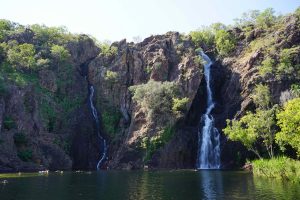
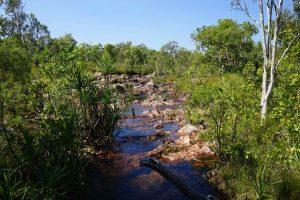 We ended up at Wangi Falls, a pair of tall waterfalls 84 metres (276 ft) high that run continuously throughout the dry winter season. This is due to the land above the Falls acting as a “sponge” during the rainy season and it contributes to an impressive steady flow of water. We did the loop around the falls which included a fairly good ascent and, of course, descent. The area is fairly lush even in this dry season and has many beautiful palm trees giving it a tropical rain forest feel. We heard the familiar sound of the screaming fox bats and saw hundreds of them when looking up! It seemed a little odd to see these mammals hanging upside down from the palm frowns.
We ended up at Wangi Falls, a pair of tall waterfalls 84 metres (276 ft) high that run continuously throughout the dry winter season. This is due to the land above the Falls acting as a “sponge” during the rainy season and it contributes to an impressive steady flow of water. We did the loop around the falls which included a fairly good ascent and, of course, descent. The area is fairly lush even in this dry season and has many beautiful palm trees giving it a tropical rain forest feel. We heard the familiar sound of the screaming fox bats and saw hundreds of them when looking up! It seemed a little odd to see these mammals hanging upside down from the palm frowns.
We packed in our lunch and enjoyed it at the Wangi Falls. These falls have two separate long falls with the large pool below them and is a popular swimming spot…at least when there are no crocs present! We didn’t swim but enjoyed our cucumber, tomato, avocado salad served with a crumbly cheddar cheese, Swiss cheese, salami and crackers!
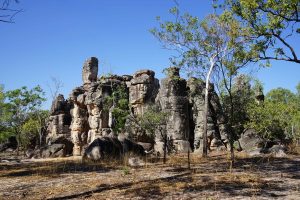
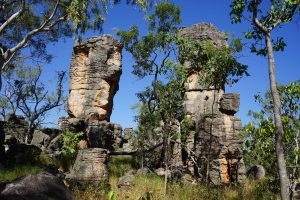 Another stop on the way back to our cabin – The “Lost City”. This was accessible by four wheel drive. After driving around 11 km, we came upon these enormous and numerous freestanding sandstone pillars that look somewhat like the ruins of an ancient city or civilization. Erosion over millions of years of course is the explanation of these formations.
Another stop on the way back to our cabin – The “Lost City”. This was accessible by four wheel drive. After driving around 11 km, we came upon these enormous and numerous freestanding sandstone pillars that look somewhat like the ruins of an ancient city or civilization. Erosion over millions of years of course is the explanation of these formations.
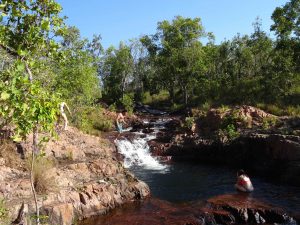
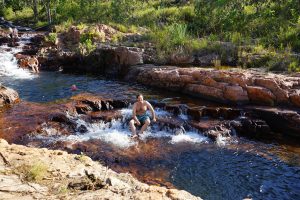 Our final stop for the day was another popular one, the Buley Rockhole Falls. These are a series of small cascading falls with large pools after each set, terrific for swimming in the late afternoon heat. I joined a few of the swimmers here for a refreshing dip! There are another set of Falls in this area supposedly worth a visit, the Florence Falls. But the day was getting late and we had packed in a full day at this point.
Our final stop for the day was another popular one, the Buley Rockhole Falls. These are a series of small cascading falls with large pools after each set, terrific for swimming in the late afternoon heat. I joined a few of the swimmers here for a refreshing dip! There are another set of Falls in this area supposedly worth a visit, the Florence Falls. But the day was getting late and we had packed in a full day at this point.
This pretty much ends our visit to Australia’s Northern Territory! Kinda sad to leave this unique most interesting area of the world, but more to be seen along the northeast coast of Queensland. Off to Darwin to catch the flight to Cairns!
Mike!
Your descriptive writing made me feel almost like I was there with you. However I’m glad I wasn’t and I’m fearless. LOL
I see Dave and Mary have caught up with you. Tell them I said Hey